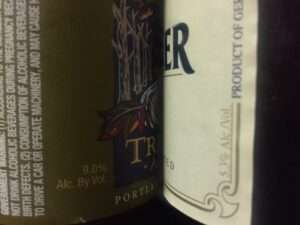Why are some beers stronger than others?

While hosting brewery tours here in Asheville, I get asked a wide variety of questions regarding the brewing process, but some come up more often than others. For those who are unable to visit Asheville to take a brewery tour, I thought I’d start a series to answer some of them here. In our first edition we will tackle the following common question on tours:
Why are some beers higher in alcohol than others?
We all know that beers come in different strengths. There is no simple answer to the question, “What is the alcohol content of beer”. An Ordinary Bitter from England may only hover around 3% ABV, while an American Barleywine might reach 13%. How does the brewer control it? The most common way is to control the amount of barley versus the amount of beer being brewed.
What does ABV stand for?
ABV stands for Alcohol By Volume, the standard way to measure how much of a liquid (beer, wine, spirits) is pure alcohol. In the old days some countries used ABW (alcohol by weight) instead. If you come across a reference like that, just remember that alcohol is very light. A 5% ABW beer will get your drunk a lot faster than a 5% ABV beer!
Alcohol in beer
Variables such as the length of the fermentation, the amount of yeast added to the fermentor, etc., are not as significant. During fermentation, yeast begin with a growth phase. They increase their cell count before fermenting the wort into beer. Though proper pitching rates are valuable for a variety of reasons, the amount of yeast added is not the main factor in determining final ABV.
Also, once the sugars are consumed, the yeast will flocculate, or drop out of suspension and settle to the bottom of the fermentor. Once this happens, the brewers know that the fermentation is nearing completion. The yeast can only consume the sugars that are available, so increasing the amount of time the yeast is in the fermentor also has little affect on final ABV.
Brewers can make other adjustments during the brewing process to help hit their target ABV in the finished product. Adding other sources of simple sugars, such as syrups, to the boil kettle, boiling the wort for an extended period of time to remove some of the excess water and concentrate the sugars, or using yeast strains that consume slightly more sugar than others before dropping out are all more subtle ways that brewers can affect ABV in their finished beer.
The biggest factor remains how much fermentable sugar the yeast have available to consume during fermentation. The more there is, the higher the ABV of the finished beer. The number one source for fermentable sugar in most worts is from malted barley.
In short, the following diagram illustrates (rather simply) the principle:
1000lbs of barley in 1000 gallons of wort = X% alcohol in the finished beer
1000lbs of barley in 2000 gallons of wort = 1/2X% alcohol in the finished beer
1000lbs of barley in 500 gallons of wort = 2X% alcohol in the finished beer
I hope that clears things up a little regarding how brewers can control the ABV of their beers. For more information or if you have a question you’d like answered, send me an email! Or even better, come to Asheville and take one of BREW-ed’s brewery tours!

